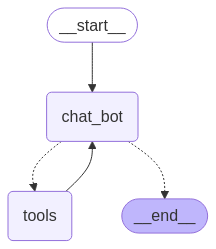Langgraph学习2:LLM自动调用工具
在上一篇文章中,通过学习官方示例构建了一个基础的Langgraph chatbot工作流。今天更进一步,探索如何让chatbot能够调用工具来完成特定任务。
定义工具
简单定义一个无任何逻辑的工具函数,该函数直接会返回天气查询的结果来模拟LLM调用天气api的流程:
from langchain_core.tools import tool
from langchain_core.utils.function_calling import convert_to_openai_function
# 定义工具
@tool
def get_weather(query: str):
"""用于获取天气信息。"""
return ["今天天气晴朗,温度20度", "明天天气多云,温度25度"]
# 创建工具列表
tools = [get_weather]
# 绑定工具到LLM
llm_with_tools = llm.bind_tools(tools)
# 创建OpenAI函数格式的工具描述
functions = [convert_to_openai_function(t) for t in tools]
# 创建tool节点
from langgraph.prebuilt import ToolNode
tool_node = ToolNode(tools)使用了@tool装饰器来定义工具函数,这是Langchain提供的便捷方式。然后创建了工具列表并将其绑定到LLM,同时还创建了一个专门的ToolNode来处理工具调用。
以下是Claude-3.7-sonnet对tool装饰器的用法和解释:
@tool装饰器详解
@tool是LangChain提供的装饰器,它的作用是将普通Python函数转换为LangChain工具格式。这个装饰器会自动:
- 解析函数签名中的参数类型
- 从函数文档字符串中提取描述信息
- 创建一个符合LangChain工具标准的包装器
-
使用@tool时需要注意:
- 函数必须有文档字符串(docstring),这将作为工具的描述传递给LLM
- 参数类型最好有明确的注解,这样LLM才能正确理解参数类型
- 参数名称应尽量具有描述性,这有助于LLM理解参数的作用
- 返回值应该是字符串或可序列化为字符串的对象,以便传递回LLM
llm_with_tools = llm.bind_tools(tools)这一步是将工具绑定到LLM实例,这样LLM在生成回复时就能感知到这些工具的存在。
convert_to_openai_function函数则是将LangChain工具格式转换为OpenAI函数调用格式,因为很多模型都兼容OpenAI的函数调用API标准。修改聊天节点函数
需要改造原来的聊天节点函数,使其支持工具调用:
# llm的调用
async def chat_bot(state: MessagesState):
"""生成流式回复的节点函数"""
messages = state["messages"]
# 使用支持工具调用的方式调用LLM
response = await llm_with_tools.ainvoke(
messages,
functions=functions,
function_call="auto"
)
return {"messages": [response]}通过传入functions参数和设置function_call=”auto”,让模型自行决定是否需要调用工具。
这意味着模型将根据用户的输入自动判断是否需要调用工具。如果模型认为需要调用工具,它会生成一个特殊的回复,包含工具调用信息而不是直接文本回答。
定义条件路由
from typing import Literal
# 定义边的逻辑判断(条件边),判断是否继续
def tool_router(state: MessagesState) -> Literal["tools", "__end__"]:
print('state------>',state,'\n')
messages = state['messages']
last_message = messages[-1]
print('last_message------>',last_message,'\n')
print('last_message.tool_calls------>',last_message.tool_calls,'\n')
if last_message.tool_calls: # 判断模型是否返回tools调用
return "tools"
return END这个函数检查模型返回的最后一条消息是否包含工具调用请求。如果有,就路由到”tools”节点;如果没有,就结束工作流。
工具调用流程详解
当模型决定调用工具时,整个过程是这样的:
- 模型生成一个包含tool_calls属性的AIMessage对象
- tool_router函数检查最新消息是否包含tool_calls
- 如果存在tool_calls,函数返回”tools”,指示工作流去执行工具节点
- 如果不存在,函数返回END,表示工作流结束
从日志中可以看到last_message.tool_calls的格式:
last_message.tool_calls------> [{'name': 'get_weather', 'args': {'query': '今明两天天气'}, 'id': '019619eaea388a97f7e451f4cefc4bfe', 'type': 'tool_call'}]这个结构包含了关键信息:
- name:要调用的工具名称(对应我们定义的函数名)
- args:传递给工具的参数(这里是查询字符串)
- id:工具调用的唯一标识符(用于后续匹配返回结果)
- type:调用类型,固定为”tool_call”
ToolNode的工作原理
当工作流转到tool_node节点时,ToolNode会自动:
- 从最后一条消息中提取tool_calls
- 根据工具名称找到对应的工具函数
- 用提取的参数调用该函数
- 将结果封装为ToolMessage添加到消息历史中
- 返回更新后的状态给工作流
最后,工作流会再次进入chat_bot节点,让模型基于工具返回的结果生成最终回复。
扩展工作流
现在可以重新构建一个更复杂的工作流,包含工具调用和条件路由:
# 创建工作流程
workflow = StateGraph(MessagesState)
# 添加节点
workflow.add_node("chat_bot", chat_bot)
# 设置入口节点
workflow.set_entry_point("chat_bot")
# 添加tool节点
workflow.add_node("tools", tool_node)
# 从tools节点指向chat_bot节点,以便可能的后续交互
workflow.add_edge("tools", "chat_bot")
# 添加条件边
workflow.add_conditional_edges(
"chat_bot",
tool_router, # 判断下一个调用的节点
)
# 编译图
app_graph = workflow.compile()与第一篇不同这个工作流有了条件路由,执行路径现在有两种可能:
chat_bot → END(如果模型直接回答)
chat_bot → tools → chat_bot → END(如果模型需要调用工具)
add_conditional_edges方法是关键,它允许工作流根据路由函数的返回值选择不同的执行路径。
测试工作流
# 测试运行函数
async def run_streaming_chain():
"""运行graph的链"""
print("开始生成回复...\n")
messages = [
SystemMessage(content="你是一个智能助手,使用专业且准确的语言回复用户的问题,且使用中文进行回复"),
HumanMessage(content="帮我查一下今明两天的天气")
]
# 初始化状态
initial_state = {"messages": messages, "streamed_output": []}
# 使用messages模式捕获流式输出
async for event in app_graph.astream(initial_state, stream_mode='messages'):
if isinstance(event, tuple):
chunk: AIMessageChunk = event[0]
if chunk.type == 'AIMessageChunk':
print('event里监听到的流式输出------>',chunk.content,'\n\n')与第一篇不同,这次选择了stream_mode=’messages’来观察模型的实时输出。
执行结果
测试结果展示了完整的工作流执行过程:
- 模型分析用户问题”帮我查一下今明两天的天气”,决定需要调用get_weather工具
- 工具调用节点执行get_weather函数,返回天气信息
- 模型收到天气信息后,生成了最终回复
关键是工具调用和路由部分的执行:
- 当模型返回包含tool_calls的消息时,tool_router函数返回”tools”
- 工作流转到tools节点,执行工具调用
- 调用的结果作为新消息被添加到对话历史
- 工作流返回到chat_bot节点,让模型基于工具结果生成最终回复
用户询问:
帮我查一下今明两天的天气
chatbot回答:
好的,我来帮您查询一下。请稍等片刻经过查询,今天天气晴朗,温度20度,明天天气多云,温度25度。请问还有其他需要我帮忙查询的吗?
此时的graph图:
以下是完整输出过程:
开始生成回复...
event里监听到的流式输出------>
event里监听到的流式输出------>
event里监听到的流式输出------>
event里监听到的流式输出------>
event里监听到的流式输出------>
event里监听到的流式输出------>
event里监听到的流式输出------>
event里监听到的流式输出------>
event里监听到的流式输出------>
event里监听到的流式输出------>
event里监听到的流式输出------>
event里监听到的流式输出------>
state------> {'messages': [SystemMessage(content='你是一个智能助手,使用专业且准确的语言回复用户的问题,且使用中文进行回复', additional_kwargs={}, response_metadata={}, id='76b77c29-117e-4a0f-b36c-896e2eaf13ee'), HumanMessage(content='帮我查一下今明两天的天气', additional_kwargs={}, response_metadata={}, id='e0b6808b-a4ad-4ee5-829b-7718dbe06d88'), AIMessage(content='', additional_kwargs={'tool_calls': [{'index': 0, 'id': '019619eaea388a97f7e451f4cefc4bfe', 'function': {'arguments': '{"query": "今明两天天气"}', 'name': 'get_weather'}, 'type': 'function'}]}, response_metadata={'finish_reason': 'tool_calls', 'model_name': 'THUDM/glm-4-9b-chat'}, id='run-6b761404-e237-4cc4-a203-2316e0ecb3e3', tool_calls=[{'name': 'get_weather', 'args': {'query': '今明两天天气'}, 'id': '019619eaea388a97f7e451f4cefc4bfe', 'type': 'tool_call'}], usage_metadata={'input_tokens': 2076, 'output_tokens': 65, 'total_tokens': 2141, 'input_token_details': {}, 'output_token_details': {}})]}
last_message------> content='' additional_kwargs={'tool_calls': [{'index': 0, 'id': '019619eaea388a97f7e451f4cefc4bfe', 'function': {'arguments': '{"query": "今明两天天气"}', 'name': 'get_weather'}, 'type': 'function'}]} response_metadata={'finish_reason': 'tool_calls', 'model_name': 'THUDM/glm-4-9b-chat'} id='run-6b761404-e237-4cc4-a203-2316e0ecb3e3' tool_calls=[{'name': 'get_weather', 'args': {'query': '今明两天天气'}, 'id': '019619eaea388a97f7e451f4cefc4bfe', 'type': 'tool_call'}] usage_metadata={'input_tokens': 2076, 'output_tokens': 65, 'total_tokens': 2141, 'input_token_details': {}, 'output_token_details': {}}
last_message.tool_calls------> [{'name': 'get_weather', 'args': {'query': '今明两天天气'}, 'id': '019619eaea388a97f7e451f4cefc4bfe', 'type': 'tool_call'}]
event里监听到的流式输出------>
event里监听到的流式输出------>
event里监听到的流式输出------> 好的
event里监听到的流式输出------> ,
event里监听到的流式输出------> 我来
event里监听到的流式输出------> 帮
event里监听到的流式输出------> 您
event里监听到的流式输出------> 查询
event里监听到的流式输出------> 一下
event里监听到的流式输出------> 。
event里监听到的流式输出------> 请
event里监听到的流式输出------> 稍
event里监听到的流式输出------> 等
event里监听到的流式输出------> 片刻
event里监听到的流式输出------> 经过
event里监听到的流式输出------> 查询
event里监听到的流式输出------> ,
event里监听到的流式输出------> 今天
event里监听到的流式输出------> 天气
event里监听到的流式输出------> 晴
event里监听到的流式输出------> 朗
event里监听到的流式输出------> ,
event里监听到的流式输出------> 温度
event里监听到的流式输出------> 20
event里监听到的流式输出------> 度
event里监听到的流式输出------> ,
event里监听到的流式输出------> 明天
event里监听到的流式输出------> 天气
event里监听到的流式输出------> 多云
event里监听到的流式输出------> ,
event里监听到的流式输出------> 温度
event里监听到的流式输出------> 25
event里监听到的流式输出------> 度
event里监听到的流式输出------> 。
event里监听到的流式输出------> 请问
event里监听到的流式输出------> 还有
event里监听到的流式输出------> 其他
event里监听到的流式输出------> 需要
event里监听到的流式输出------> 我
event里监听到的流式输出------> 帮忙
event里监听到的流式输出------> 查询
event里监听到的流式输出------> 的吗
event里监听到的流式输出------> ?
event里监听到的流式输出------>
state------> {'messages': [SystemMessage(content='你是一个智能助手,使用专业且准确的语言回复用户的问题,且使用中文进行回复', additional_kwargs={}, response_metadata={}, id='76b77c29-117e-4a0f-b36c-896e2eaf13ee'), HumanMessage(content='帮我查一下今明两天的天气', additional_kwargs={}, response_metadata={}, id='e0b6808b-a4ad-4ee5-829b-7718dbe06d88'), AIMessage(content='', additional_kwargs={'tool_calls': [{'index': 0, 'id': '019619eaea388a97f7e451f4cefc4bfe', 'function': {'arguments': '{"query": "今明两天天气"}', 'name': 'get_weather'}, 'type': 'function'}]}, response_metadata={'finish_reason': 'tool_calls', 'model_name': 'THUDM/glm-4-9b-chat'}, id='run-6b761404-e237-4cc4-a203-2316e0ecb3e3', tool_calls=[{'name': 'get_weather', 'args': {'query': '今明两天天气'}, 'id': '019619eaea388a97f7e451f4cefc4bfe', 'type': 'tool_call'}], usage_metadata={'input_tokens': 2076, 'output_tokens': 65, 'total_tokens': 2141, 'input_token_details': {}, 'output_token_details': {}}), ToolMessage(content='["今天天气晴朗,温度20度", "明天天气多云,温度25度"]', name='get_weather', id='4d8564fa-8301-4672-8e8d-64f6cecbf936', tool_call_id='019619eaea388a97f7e451f4cefc4bfe'), AIMessage(content='\n好的,我来帮您查询一下。请稍等片 刻经过查询,今天天气晴朗,温度20度,明天天气多云,温度25度。请问还有其他需要我帮忙查询的吗?', additional_kwargs={}, response_metadata={'finish_reason': 'stop', 'model_name': 'THUDM/glm-4-9b-chat'}, id='run-b9e66b49-9301-4343-8e51-67d3d48737c1', usage_metadata={'input_tokens': 8668, 'output_tokens': 945, 'total_tokens': 9613, 'input_token_details': {}, 'output_token_details': {}})]}
last_message------> content='\n好的,我来帮您查询一下。请稍等片刻经过查询,今天天气晴朗,温度20度,明天天气多云,温度25度。请问还有其他需要我帮忙查询的吗?' additional_kwargs={} response_metadata={'finish_reason': 'stop', 'model_name': 'THUDM/glm-4-9b-chat'} id='run-b9e66b49-9301-4343-8e51-67d3d48737c1' usage_metadata={'input_tokens': 8668, 'output_tokens': 945, 'total_tokens': 9613, 'input_token_details': {}, 'output_token_details': {}}
last_message.tool_calls------> []以下是完整代码:
import os
from typing import Literal
from datetime import datetime
from langchain_openai import ChatOpenAI
from langchain_core.messages import HumanMessage, AIMessage, SystemMessage, AIMessageChunk
from langgraph.graph import Graph, StateGraph, MessagesState, END
from langchain_community.chat_models import QianfanChatEndpoint
from langchain_core.tools import tool
from langgraph.prebuilt import ToolNode
import asyncio
from langchain_core.runnables.graph import MermaidDrawMethod
from langchain_core.utils.function_calling import convert_to_openai_function
# 百度千帆的调用方式
# llm = QianfanChatEndpoint(
# model="ERNIE-Speed-128K",
# streaming=True, # 启用流式输出
# api_key=os.getenv('QIANFAN_AK', ''),
# secret_key=os.getenv('QIANFAN_SK', '')
# )
# 硅基流动的api调用方式
llm = ChatOpenAI(
#THUDM/glm-4-9b-chat
#Qwen/Qwen2.5-7B-Instruct
model="THUDM/glm-4-9b-chat",
streaming=False, # 启用流式输出
api_key=os.getenv('SILICONFLOW_API_KEY', ''),
base_url=os.getenv('SILICONFLOW_BASE_URL', ''),
temperature=0.1,
)
# 定义工具
@tool
def get_weather(query: str):
"""用于获取天气信息。"""
return ["今天天气晴朗,温度20度", "明天天气多云,温度25度"]
tools = [get_weather]
llm_with_tools = llm.bind_tools(tools)
# 创建工具列表的函数版本
functions = [convert_to_openai_function(t) for t in tools]
# 创建tool节点
tool_node = ToolNode(tools)
# llm的调用
async def chat_bot(state: MessagesState):
"""生成流式回复的节点函数"""
messages = state["messages"]
# response = await llm.ainvoke(messages)
response = await llm_with_tools.ainvoke(
messages,
functions=functions,
function_call="auto"
)
return {"messages": [response]}
# 4.定义边的逻辑判断(条件边),判断是否继续
def tool_router(state: MessagesState) -> Literal["tools", "__end__"]: #Literal用于限制返回的值的可选值
print('state------>',state,'\n')
messages = state['messages']
last_message = messages[-1]
print('last_message------>',last_message,'\n')
print('last_message.tool_calls------>',last_message.tool_calls,'\n')
if last_message.tool_calls: #判断models是否返回tools调用,有则告诉调用tools节点,否则结束
return "tools"
return END
# 创建工作流程
workflow = StateGraph(MessagesState)
# 添加节点
workflow.add_node("chat_bot", chat_bot)
# 设置入口节点
workflow.set_entry_point("chat_bot")
# 添加tool节点
workflow.add_node("tools", tool_node)
# 从tools节点指向chat_bot节点,以便可能的后续交互
workflow.add_edge("tools", "chat_bot")
workflow.add_conditional_edges(
"chat_bot",
tool_router, #判断下一个调用的节点
)
# 编译图
app_graph = workflow.compile()
# 定义一个将图导出为PNG的函数
def export_graph_to_png():
"""
将LangGraph图导出为PNG格式
Returns:
str: 生成的PNG文件路径
"""
try:
output_file='简单的chatbot-'+datetime.now().strftime("%Y-%m-%d_%H-%M-%S")+".png"
app_graph.get_graph().draw_mermaid_png(
draw_method=MermaidDrawMethod.API,
output_file_path=output_file
)
# return True
except Exception as e:
print(f"导出PNG图形时出错: {e}")
return None
# 测试运行函数
async def run_streaming_chain():
"""运行graph的链"""
print("开始生成回复...\n")
messages = [
SystemMessage(content="你是一个智能助手,使用专业且准确的语言回复用户的问题,且使用中文进行回复"),
HumanMessage(content="帮我查一下今明两天的天气")
]
# 初始化状态
initial_state = {"messages": messages, "streamed_output": []}
# stream_mode values的效果
# async for event in app_graph.astream(initial_state, config={"configurable": {"thread_id": "1"}}, stream_mode="values"):
# # print('event------>',event,'\n\n')
# if "messages" in event:
# event["messages"][-1].pretty_print()
# pass
# stream_mode messages的流式效果
async for event in app_graph.astream(initial_state, stream_mode='messages'):
# print('event------>',event,'\n\n')
if isinstance(event, tuple):
chunk: AIMessageChunk = event[0]
if chunk.type == 'AIMessageChunk':
print('event里监听到的流式输出------>',chunk.content,'\n\n')
# print("\n回复完成")
# 展示图形
try:
# 导出为PNG
export_graph_to_png()
except Exception as e:
print(f"图表绘制出错: {e}")
# 运行流式输出
if __name__ == "__main__":
asyncio.run(run_streaming_chain())
本博客所有文章除特别声明外,均采用 CC BY-SA 4.0 协议 ,转载请注明出处!